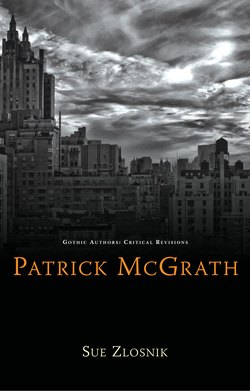Patrick McGrath

Реклама. ООО «ЛитРес», ИНН: 7719571260.
Оглавление
Sue Zlosnik. Patrick McGrath
Отрывок из книги
PATRICK McGRATH
Gothic Authors: Critical Revisions is dedicated to publishing innovative introductory guides to writers of the Gothic. The series explores how new critical approaches and perspectives can help us to recontextualize an author’s work in a way that is both accessible and informative. The series publishes work that is of interest to students of all levels and teachers of the literary Gothic and cultural history.
.....
McGrath was to devote an entire novel to the artist in Port Mungo (2004), which is one of the novels discussed in chapter 3. This chapter considers the first three works from the twenty-first century, Martha Peake (2000) and Ghost Town (2005) as well as Port Mungo. In this period of his fiction, issues of historicity, national and personal identity and the figure of the artist become central concerns. Martha Peake takes a final self-reflexive look at earlier period Gothic as a way of enacting the abandonment of a culturally haunted England in favour of the New World, a movement that parallels McGrath’s own departure for North America after university. As the later fiction shows, however, haunting is not confined to the Old World. The weight of history and how it has been constructed continue to make themselves felt in the present of this fiction. These novels and stories continue to probe the haunting of the past and, in so doing, are themselves haunted by ghosts of the Gothic. In the Afterword, McGrath’s repudiation of the term ‘Gothic’ is considered in relation to his most recent novel, Trauma, together with the implications for his future work.
Such rationalization, however, is also treacherous because elements of the uncanny remain in the story. In characteristic Gothic mode, the boundary between life and death is rendered unstable. The narrative is interspersed with Congo Bill’s malarial delusions, in which he is back in the paradise of the Congo forest. The narrative also describes how, in effect, he had been brought back from the dead by the pygmies, who have three categories of death: as well as ‘dead’, there is ‘dead forever’ and ‘absolutely dead’ (101). A similar resurrection takes place with the monkey, who appears to die in the course of the story. Frank has been befriended by the landlord’s daughter, Meg, who had initially terrified him with her approach, although the ‘slow, heavy clump-clump-clump’ is revealed to be created by an orthopaedic boot (93). It is Meg who dresses the monkey in a ‘tiny gown of white lace’ and helps him place it in a shoebox for burial – in the cellar where the murders are taking place. The monkey’s revival down in the cellar (it was ‘clearly not dead forever’ (103)) leads to Frank’s discovery and his murder alongside his mother. The story ends with Congo Bill coming out of his delirium and spotting Meg making for the woods with the monkey on her shoulder. The figure of the monkey plays an uncanny role. Not the hallucinatory spectre of LeFanu’s ‘Green Tea’, its status in this story is nonetheless liminal. It signifies the permeability of the boundary between life and death, as well as the frailty of human identity, in spite of the rational scientific discourse that has explained the bizarre events at the inn. In the 1930s England of this story, infection and degeneracy are endemic in the English countryside; the threat is not the exotic but the domestic. This is contained by medical science at the end of the story, but the uncanny figure of the monkey is unsettling, reminding the reader of the limitations in understanding of its rational practices.
.....